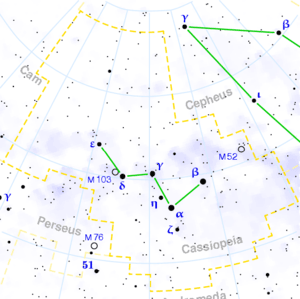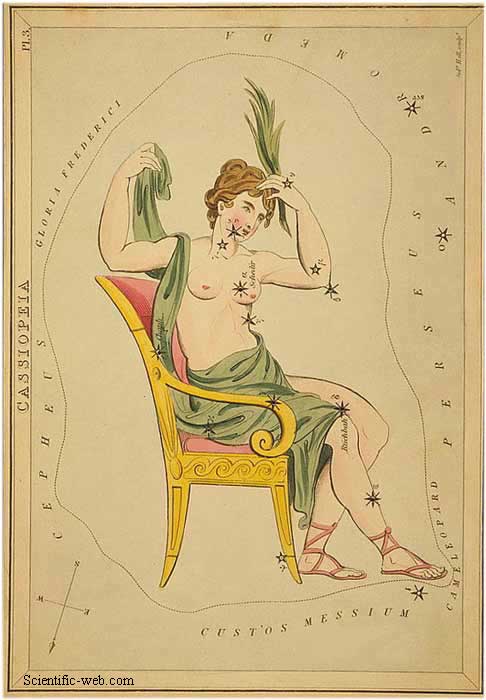|
|
Cassiopeia is a northern constellation which Greek mythology considered to represent the vain queen Cassiopeia who boasted about her unrivaled beauty. It is one of the 88 modern constellations, and was also one of the 48 listed by Ptolemy. Notable features Cassiopeia contains two stars visible to the naked eye that rank among the most luminous in the galaxy: ρ Cas and V509 Cas. The star η Cas is a nearby (19.4 ly) binary star comprising a yellow Sun-like dwarf and an orange dwarf star. Cassiopeia looks like a W or a crown. If we were to observe Earth's Sun from Alpha Centauri, the Sun would appear to be in Cassiopeia as a yellow-white 0.5 magnitude star. The famous "W" of Cassiopeia would become a zig-zag pattern with the Sun at the leftmost end, closest to ε Cas. Two Messier objects, Messier 52 (NGC 7654) and Messier 103 (NGC 581) are located in Cassiopeia. Both are open clusters and being 7th apparent magnitude objects they are easy targets with binoculars. The supernova known as Tycho's Star, or SN1572, was widely observed in Cassiopeia in 1572. The scientific description of this star was written by Tycho Brahe, and its appearance is said to have lead Johannes Kepler to become an astronomer. See also * Messier 52 open cluster References * Krause O, Rieke GH, Birkmann SM, Le Floc'h E, Gordon KD, Egami E, Bieging J, Hughes JP, Young ET, Hinz JL, Quanz SP, Hines DC (2005). "Infrared echoes near the supernova remnant Cassiopeia A". Science 308 (5728): 1604-6. PMID 15947181. * Ian Ridpath and Wil Tirion (2007). Stars and Planets Guide
Retrieved from "http://en.wikipedia.org/"
|
|
||||||||||||||||||||||||||||||||||||||||||||||||||||


